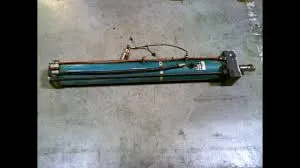Oct . 20, 2024 23:51 Back to list
Hydraulic Cylinder Solutions for Engine Lifting Applications and Mechanisms
Understanding Engine Lift Hydraulic Cylinder Products A Comprehensive Overview
In the world of automotive engineering and maintenance, the significance of hydraulic engineering cannot be overstated. Among the myriad components that facilitate the smooth operation of vehicles, the engine lift hydraulic cylinder stands out as an essential tool for both professional mechanics and DIY enthusiasts. This article delves into the various aspects of engine lift hydraulic cylinder products, including their design, functionality, applications, and maintenance tips.
What is an Engine Lift Hydraulic Cylinder?
An engine lift hydraulic cylinder is a vital component in lifts that are used to raise and lower heavy engine components safely. Utilizing hydraulic fluid under pressure, these cylinders can generate significant lifting force to maneuver engines or other heavy machinery. The basic operation of a hydraulic cylinder relies on Pascal's principle, which states that pressure applied to a confined fluid is transmitted undiminished in all directions.
Key Features and Benefits
1. High Load Capacity Engine lift hydraulic cylinders are designed to handle heavy loads efficiently. They can lift engines that weigh hundreds to thousands of pounds, making them indispensable in workshops and garages.
2. Precision Control Modern hydraulic cylinders come equipped with valves that allow for precise control over the lifting and lowering process. This precision is crucial when working with delicate components where damage can be costly.
3. Durability and Longevity Constructed from high-quality materials such as steel and aluminum, hydraulic cylinders are built to withstand the rigors of lifting heavy loads. Proper maintenance can significantly extend their lifespan.
4. Versatility These cylinders are not only used for lifting engines but also for various applications in automotive repair, construction, and manufacturing where heavy objects need to be moved safely.
Types of Engine Lift Hydraulic Cylinders
There are several types of hydraulic cylinders suited for engine lifting applications
1. Single-Acting Cylinders These cylinders use hydraulic pressure to lift but rely on gravity or a spring to return to their original position. They are simpler and often more cost-effective but are limited in functionality.
2. Double-Acting Cylinders Offering more control and lifting power, double-acting cylinders can lift as well as lower the load by applying pressure on both sides of the piston, making them ideal for more complex lifting jobs.
engine lift hydraulic cylinder products

3. Telescopic Cylinders These cylinders comprise multiple layers that extend and retract, allowing for a greater lifting height without needing additional space. They are particularly useful in tight working environments.
Applications of Engine Lift Hydraulic Cylinders
These hydraulic cylinders are primarily employed in
- Automotive Workshops Used for efficiently lifting engines during repairs or replacements, allowing mechanics to work comfortably without straining their backs. - Construction Sites Employed for hoisting heavy machinery or components. - Industrial Production Used in assembly lines where heavy equipment needs to be moved frequently.
Maintenance Tips for Engine Lift Hydraulic Cylinders
To ensure longevity and optimal performance of your hydraulic cylinders, consider the following maintenance tips
1. Regular Inspection Check for any leaks, cracks, or signs of wear regularly. Addressing these issues early can prevent larger problems down the line.
2. Lubrication Keep the moving parts well-lubricated to reduce wear and tear. Follow the manufacturer's recommendations regarding lubricants and maintenance schedules.
3. Hydraulic Fluid Levels Ensure that the hydraulic fluid is at the proper level and is clean. Contaminated fluid can hinder performance and cause damage.
4. Avoid Overloading Always abide by the manufacturer's weight limitations to avoid damaging the cylinder or risking accidents during use.
5. Proper Storage Store hydraulic cylinders in a dry, clean environment to prevent rust and corrosion.
Conclusion
Engine lift hydraulic cylinder products are invaluable in the automotive and heavy machinery sectors, providing unparalleled strength and precision for lifting heavy components safely. Understanding their design, types, applications, and maintenance will aid in selecting the right product for your needs and ensure safe operations. Whether you're an auto technician or a project manager in construction, investing in high-quality hydraulic cylinders is essential for achieving efficiency and safety in lifting applications.
-
1.5 Ton Lifting Cylinder-Hebei Shenghan|Precision Engineering&Customization
NewsAug.07,2025
-
Turbocharged 1.5 Ton Cylinder | Model 80/95-40/60-35-124
NewsAug.07,2025
-
1.5 Ton Lifting Cylinder - Hebei Shenghan|High Load, Durable, Custom
NewsAug.06,2025
-
1.5 Ton Lifting Cylinder 70/82-40-290-535 - Hebei Shenghan Hydraulic Machinery Co. Ltd.|Precision Lifting&Heavy-Duty Performance
NewsAug.06,2025
-
1.5 Ton Lifting Cylinder 70/82-40-290-535 - Hebei Shenghan | Heavy-Duty Hydraulic Solutions
NewsAug.06,2025
-
1.5-Ton Lifting Cylinder-Hebei Shenghan|Precision Hydraulic Solutions&Custom Industrial Lifting
NewsAug.06,2025
